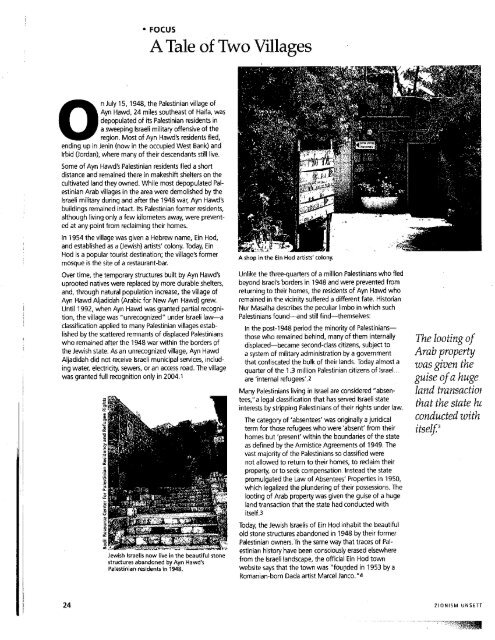zionism_unsettled_scan
zionism_unsettled_scan
zionism_unsettled_scan
Create successful ePaper yourself
Turn your PDF publications into a flip-book with our unique Google optimized e-Paper software.
• FOCUS<br />
A Tale of Two Villages<br />
On July 15, 1948, the Palestinian village of<br />
Ayn Hawd, 24 miles southeast of H~ifa, was<br />
depopulated of its Palestinian residents in<br />
a sweeping Israeli military offensive of the<br />
region. Most of Ayn Hawd's residents fled,<br />
ending up in Jenin (now in the occupied West Bank) and<br />
Irbid (Jordan), where many of their descendants still live.<br />
Some of Ayn Hawd's Palestinian residents fled a short<br />
distance and remained there in makeshift shelters on the<br />
cultivated land they owned. While most depopulated Palestinian<br />
Arab villages in the area were demolished by the<br />
Israeli military during and after the 1948 war, Ayn Hawd's<br />
buildings remained intact. Its Palestinian former residents,<br />
although living only a few kilometers away, were prevented<br />
at any point from reclaiming their homes.<br />
In 1954 the village was given a Hebrew name, Ein Hod,<br />
and established as a (Jewish) artists' colony. Today, Ein<br />
Hod is a popular tourist destination; the village's former<br />
mosque is the site of a restaurant-bar.<br />
Over time, the temporary structures built by Ayn Hawd's<br />
uprooted natives were replaced by more durable shelters,<br />
and, through natural population increase, the village of<br />
Ayn Hawd Aljadidah (Arabic for New Ayn Hawd) grew.<br />
Until 1992, when Ayn Hawd was granted partial recognition,<br />
the village was "unrecognized" under Israeli law-a<br />
classification applied to many Palestinian villages established<br />
by the scattered remnants of displaced Palestinians<br />
who remained after the 1948 war within the borders pf<br />
the Jewish state. As an unrecognized village, Ayn Hawd<br />
Aljadidah did not receive Israeli municipal services, including<br />
water, electricity, sewers, or an access road. The village<br />
was granted full recognition only in 2004.1<br />
Jewish Israelis now live in the beautiful stone<br />
structures abandoned by Ayn Hawd's<br />
Palestinian residents in 1948.<br />
A shop in the Ein Hod artists' colony.<br />
Unlike the three-quarters of a million Palestinians who fled<br />
beyond Israel's borders in 1948 and were prevented from<br />
returning to their homes, the residents of Ayn Hawd who<br />
remained in the vicinity suffered a different fate. Historian<br />
Nur Masalha describes the peculiar limbo in which such<br />
Palestinians found-and still find-themselves:<br />
In the post-1948 period the minority of Palestiniansthose<br />
who remained behind, many of them internally<br />
displaced-became second-class citizens, subject to<br />
a system of military administration by a government<br />
that confiscated the bulk of their lands. Today almost a<br />
quarter of the 1.3 million Palestinian citizens of Israel ...<br />
are 'internal refugees'.2<br />
Many Palestinians living in Israel are considered "absentees,"<br />
a legal classification that has served Israeli state<br />
interests by stripping Palestinians of their rights under law.<br />
The category of 'absentees' was originally a juridical<br />
term for those refugees who were 'absent' from their<br />
homes but 'present' within the boundaries of the state<br />
as defined by the Armistice Agreements of 1949. The<br />
vast majority of the Palestinians so classified were<br />
not allowed to return to their homes, to reclaim their<br />
property, or to seek compensation. Instead the state<br />
promulgated the Law of Absentees' Properties in 1950,<br />
which legalized the plundering of their possessions. The<br />
looting of Arab property was given the guise of a huge<br />
land transaction that the state had conducted with<br />
itself.3<br />
Today, the Jewish Israelis of Ein Hod inhabit the beautiful<br />
old stone structures abandoned in 1948 by their former<br />
Palestinian owners.lh the same way that traces of Palestinian<br />
history have been consciously erased elsewhere<br />
from the Israeli landscape, the official Ein Hod town<br />
website says that the town was "founded in 1953 by a<br />
Romanian-born Dada artist Marcel Janco."4<br />
The looting of<br />
Arab property<br />
was given the<br />
guise of a huge<br />
land transactiOl<br />
that the state he<br />
conducted with<br />
itself'<br />
24<br />
ZIONISM UNSETT


